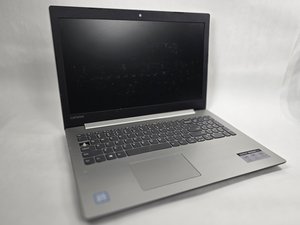crwdns2862678:0crwdne2862678:0
crwdns2895503:0crwdne2895503:0
If your Lenovo IdeaPad 330-15IKB screen is blank, frozen, or not responding, follow this troubleshooting guide.
Software Fault
Sometimes, the screen may become unresponsive due to a temporary software glitch. A force restart may resolve this issue.
- Disconnect all external devices (USB drives, printers, headphones).
- Press and hold the power button for about 10 seconds until the laptop powers off completely.
- Wait a few seconds, then press the power button again to turn the laptop on.
Battery Fault
If a force restart doesn’t work, the device might need a power cycle to reset its internal components. This can happen due to a safety trip or a battery issue.
- Unplug the charger and shut down the device.
- Flip the laptop and look for the small reset hole (often labeled with a battery icon); this device has the hole on the right side.
- Press and hold the reset button for 10-15 seconds using a paperclip or similar object.
- Reconnect the charger and power on the device.
Damaged Screen
The issue may be related to the built-in display rather than the system as a whole. You can check this by connecting an external display. This can happen because of a pinched ribbon cable near the hinge or damage to the screen.
- Connect the laptop to an external monitor or TV via HDMI.
- Power on the external display and select the correct input source.
- If the external monitor displays the screen, the issue is likely with the laptop’s display or display cable.
Corrupted BIOS/UEFI
If the external display doesn't work, the issue could be at the BIOS level. Entering the BIOS can help you verify if the system is responsive outside the operating system. This can happen due to a firmware fault or a faulty CMOS battery.
- Power off the laptop, then press the Novo button (a small button next to the power button).
- Choose BIOS Setup from the Novo Menu.
- If you can see the BIOS screen, your screen and motherboard are functional, but there may be an issue with the operating system or display driver.
Damaged Hardware
If none of the above steps work, the screen or connections might have a hardware issue. This can be caused by damage or wear and tear.
- Carefully open the laptop’s bottom panel to check for any loose or damaged display cables.
- Look for any physical damage or signs of corrosion on the internal components.
- Liquid damage from a spill could also damage vital components
- If you are unfamiliar with handling internal components, consult a professional for further inspection.
Motherboard Failure
If all other solutions fail, the motherboard could be the issue. A qualified technician should inspect the device to confirm if a motherboard replacement is necessary.


crwdns2944067:00crwdne2944067:0